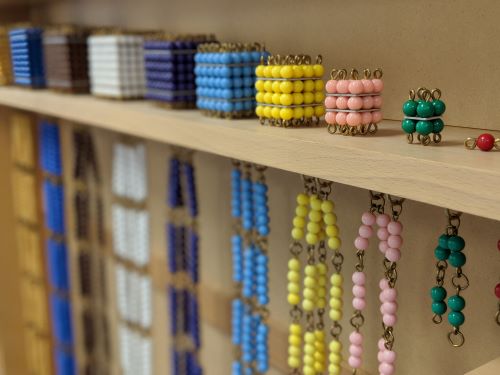MONTESSORI MATHEMATICS

Montessori Bead Material
An essential material in the mathematics center of a Montessori classroom is the beautiful bead material.
Each number 1-10 is represented by a unique color of beads.
1. Red
2. Green
3. Pink
4. Yellow
5. Light Blue
6. Purple
7. White
8. Brown
9. Dark Blue
10. Gold
The bead materials are stored in a wooden cabinet. They include the individual bead bars, short bead chains, long bead chains, bead squares and bead cubes. Children use the beads to model basic operations (addition, subtractions, multiplication, division) as well as squares and square roots. They practice skip counting, play the snake game and learn least common multiples and greatest common factors.
Golden Beads
The golden beads represent ones, tens, hundreds and thousands. They teach base ten concepts including place value, decimals, regrouping (“borrowing” and “carrying”), and money.
Number Rods
The number rods are ten wooden pieces identical in length to the sensorial red rods, but divided into red and blue sections. The shortest rod is red. The second is twice the size of the first; one half is painted red and the other half is blue. The third rod is three times the size of the first and is divided into three sections; the first painted red, the second is blue, and the third red. All the subsequent rods are divided in a similar fashion, alternating red and blue, the first section always being red.
Spindle Box
Forty-five wooden spindles are tied with ribbons and placed in the spindle box—six spindles in the compartment labeled 6, four spindles in the compartment labeled 4 and so on. The spindles clarify the idea that the numerical symbols represent a certain number of separate objects and reinforce the natural sequence of the numerals. We also use the spindles to introduce the concept of zero and its symbol.
Sandpaper Numerals
The numerals from 0 to 9 are cut out of sandpaper and mounted on individual green boards. The 0 is presented after the Spindle Boxes once the concept of zero has been introduced. The sandpaper numerals teach the child symbols for the numbers he knows.
Number Balance
The number balance allows children to solve Algebraic equations by balancing weights of identical mass at varying distances from the center, mimicking a number line.
Colored Counting Bars
The counting bars match the colors of the Montessori beads and are used to visually display addition sums and to compare the difference between various numbers (subtraction). Children learn that addition and subtraction are inverse operations.
Fraction Manipulatives
Through frequent experiences with the Fraction Circles and Fraction Skittles, young children develop an accurate sense of the meaning of fractions. Then, they expand their knowledge of fractions to include the basic operations of addition, subtraction, multiplication and division, with Attribute Blocks, UNIFIX Cubes and Pattern Blocks.
Algebra and Patterning
Sorting and categorizing activities help children develop the skills necessary to understand Algebra. Sensorial items are also repurposed for patterning activities.
Measurement Boxes
Rulers, tape measures, measuring tapes, measuring cups and spoons, the pan balance, spring scales, thermometers, sand timers, clocks stopwatches and assorted bills and coins are available for student exploration. We also use the clocks and time measurement devices in our history lessons.
Check out our Preschool Curriculum Sequence for an outline of what we teach each year of preschool or return to the Academic Foundations Page

